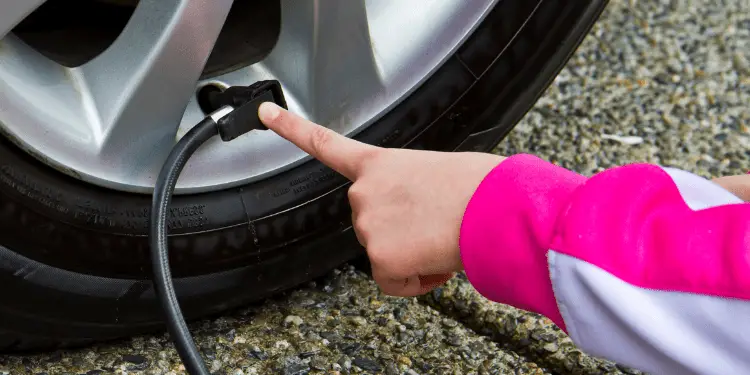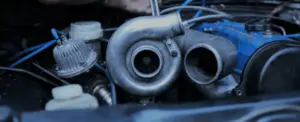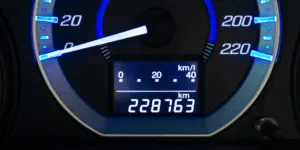There are seven reasons your car tire pressure keeps going low —and it’s important that you know what they are to fix them and prevent them from happening again.
To help you with this, let’s look at the most common reasons why your car tire keeps slowly losing air.
Nail or Screw in Your Tire
The most noticeable reason your tire pressure keeps going low is that you have a nail or screw in your tire.
Usually, a nail or screw will find its way into the rubber on the tread section of your tire because it has been driven over, but occasionally it will be kicked up by another car and end up in your sidewall.

This, again, will be very obvious if it is on the outside sidewall, but sometimes your car can pick up a nail or screw where it can ricochet off the axle and be thrown into your tire’s inner sidewall.
To rule out a screw or nail being the cause of your tire pressure going down, you may have to get underneath your car and look at the inner sidewall.
If you can’t get under the car, gently rubbing your hand around the tire’s inner circumference should alert you to any foreign object stuck there.
Bead Leaks
The area between the rim and your tire is called the bead. The bead allows a tight seal to be created with the rim and prevents air from escaping.
You can’t see the bead when the tire is inflated, but you can check to see if the area is leaking air. Sometimes there is more obvious damage to the rim that causes a leak, but we’ll discuss that in the next section below.
The best way of checking if the bead is leaking is to spray soapy water all around the rim and bead area. Any bubbles will indicate you have a bead leak.
The bead is made up of metal cords encased in rubber, and sometimes especially in the salt states, it can corrode badly and loosen the seal.
Bent Wheels or Rims
Have you hit a pothole or a curb recently? When this occurs, the damage is caused to the wheel or the rim rather than the tire.
Two things can happen when you hit a pothole or a curb. Firstly you may bend the rim or the wheel, meaning the tire can no longer sit perfectly on it.
Often a bent rim isn’t noticeable, and a lot of the damage has been done inside the area that is covered by the tire.
Therefore if you have hit a curb or a pothole and don’t see any damage, it may still be prudent to get your tire inspected because much damage can be done that isn’t obvious.

The second reason your rims or wheel can cause your air pressure to keep going down takes time to evolve.
Rims suffer from corrosion. They are made up of metal alloys normally containing aluminum and magnesium.
Although rims leave the factory with a clear protective coat, over time, the protective coat starts to degrade due to weather and also chemical reactions to salt and other chemicals on the road.
Corrosion, where the rim lip meets the tire bead, is a common cause of a tire losing air pressure.
Time To Check Your Tire Pressure?
It’s a common misconception that tires will not lose air unless there is a defect in the rim or the tire itself.
Air under pressure will force its way through your tire’s rubber compound and escape into the atmosphere. There is nothing that can be done about this is just nature.
Normal air pressure loss is between 1 to 3 PSI per month. If you are only losing this much air, then you need not look any further for the causes of a leak, as this is natural tire leakage and is to be expected.
If you’re not happy losing this amount naturally, you could use nitrogen in your tires.
This is a lot more expensive than air, but because nitrogen molecules are bigger than air molecules, they have a tougher time working through the rubber compound.
Therefore your tire pressure will be maintained for longer.

For most people, this is a luxury they can’t afford, and as long as the tires are checked regularly and topped up, if you are only losing 1 to 3 PSI per month, you have nothing to concern yourself about.
Temperatures Changes
Tyre pressure does fluctuate due to temperature changes. Checking your car tires first thing in the morning after a cold night is likely to give a lower reading than if you tested them in the summer. Air, like every element, will expand when it is heated.
To a lesser degree, if you check your tire pressure before driving on one occasion, it is likely to be lower than checking it a second time after you have driven on the tires, which has warmed the air up inside.
Driving causes friction on the tires’ rubber, and this causes heat which warms up the air inside.
We are not talking about massive variances here but maybe one or two PSI. For every 10 degrees Fahrenheit reduction in temperature, up to 1 PSI reduction in air pressure in your tires occurs.
Therefore, taking tire pressure readings at different times of the day, the season, or after being driven on can slightly affect the tire pressure readings and may falsely tell you that your tire pressure is going low when it’s not the case.
Related Article: Tire Pressure Light Blinking But Everything Fine – [SOLVED]
Worn Tires
Anything that ages become less effective over time. Tires are no exception. Due to reactions with road salt and other chemicals, tire rubber loses its suppleness and can start to turn brown and crack.
As highlighted, pressurized air will escape to low pressure, and if your tire is less structurally sound, this process can quicken.

Therefore it’s important to realize that although tire tread is important, so is the tire’s structural integrity. Small weather cracks will allow more pressurized air to leak into the environment quicker than good quality supple new tires.
Popular Related Article: The 4 Places Used Tire Shops Get Their Tires From
Tire Valve Leaking
The last reason your tire pressure might keep going low is a faulty tire valve. A really simple check is to turn the valve with your finger and thumb and ensure it is tight.
Secondly, take off the tire cap and look inside the valve for any dirt or debris that may stop the valve from closing. If you see dust or debris in this area, try sucking it out with a vacuum or maneuvering it out with a pin. Try not to push it further inside the valve, as this could cause a leak to get worse.
Sometimes the area around the rim and the tire valve seating can corrode and leak air. A very easy check is to use soapy water in the tire valve area with the tire cap off to see if bubbles occur.
A valve replacement at a tire shop will charge you around 10 to $15.
In Conclusion
If your tire pressure keeps going low, there are seven main causes.
The most likely cause is a faulty tire valve and natural leakage. Other causes are rim damage, you have taken the reading at different times when the tire is very cold, or you have a screw or nail in your tire.




![How Long Can A Tire Last With A Screw In It? [Answered] tire-with-screw-in-tread](https://carzaza.com/wp-content/uploads/2023/12/tire-with-screw-in-tread-300x224.png)








